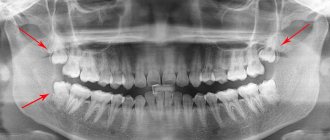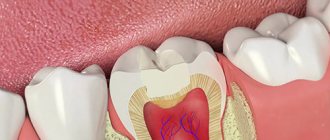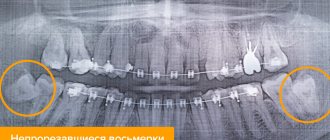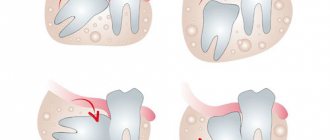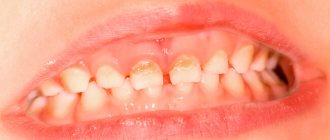Author of the article:
Soldatova Lyudmila Nikolaevna
Candidate of Medical Sciences, Professor of the Department of Clinical Dentistry of the St. Petersburg Medical and Social Institute, Chief Physician of the Alfa-Dent Dental Clinic, St. Petersburg
Dentists are often approached with such a problem as pain in the front teeth. There is nothing surprising. After all, although all our teeth have more or less the same internal structure, it is the incisors, due to their location, that are often subject to mechanical injuries.
In addition, our front teeth are distinguished by a thin layer of dentin (the bone tissue that makes up the bulk of the tooth). Because of this, caries on the incisors develops much faster than on other teeth.
Features of treatment of anterior teeth
The four incisors in the center of the upper and lower jaws are the front teeth. They are capricious, with a thin layer of enamel and dentin, caries strikes them quickly. Therefore, at the slightest discomfort, run to the dentist!
The front teeth are a very important area not only for the patient, but also for the dentist. They are always visible; everyone will notice errors in treatment. Incisors require jewelry precision from the dentist; the enamel is thinner, so the patient experiences more pain. Don’t forget about aesthetics - an incorrectly chosen filling color or poor degree of transparency will ruin the entire treatment.
The smile area requires special care. Observation should be made for crowded front teeth that overlap each other and are too large. The lack of vitamins in the body primarily affects the incisors - vitamin deficiency does not cost anything to undermine the already thin enamel. Food that often gets stuck in the interdental spaces warns of impending caries. It is better not to delay your visit to the clinic where front teeth are treated in Moscow: at the very beginning, caries is treated without the use of a drill.
Aesthetic splinting with fiberglass or ceramics
This is the most optimal splinting option. Both from the point of view of comfort (convenience) and efficiency, and from the point of view of aesthetics. This tape is durable, translucent and white in color. That is, even in the presence of interdental spaces (which appear when moving teeth “move apart” in a row), it will be barely noticeable.
Such a tape can be fixed both in the “groove” inside and on top, without damaging the enamel, but only slightly processed for improved adhesion to the material. Fixation is carried out using a light-curing filling composite.
Treatment methods – from filling to implant
The dentist will select the treatment method for the front teeth after an examination.
- Veneers or Lumineers
If the incisors are severely damaged, thin overlays can be placed - veneers or lumineers. They will hide the consequences of caries and make teeth whiter and smoother.
- Dental crowns
If only the root remains of the front tooth, intra-root inlays are made; this is the basis for the crown. Metal crowns are not suitable for front teeth; they will be too noticeable. To make an artificial tooth as similar as possible to a real one, it is better to use ceramic and zirconium crowns.
- Bridges and implants
If desired, missing front teeth can be replaced by bridges and clasp dentures. If funds allow, you can install an implant and forget about the problem for many years.
Treatment of caries of anterior teeth
The main method of treating caries in the front teeth is filling. When it comes to incisors, in the language of dentists this is called very beautifully - artistic restoration. It is better not to save on the cost of the filling. High-quality material will last longer and will not spoil your smile. The front teeth are always visible, so the dentist has to select the color and degree of transparency of the filling with pinpoint precision; it must match the shade of the tooth as closely as possible. Reflective composite materials do not spoil the aesthetic appearance. Over time, light fillings do not darken or wear off.
Modern aesthetic nanomaterials
In addition to fiberglass, today we also use more advanced aesthetic splinting materials that are more durable, biocompatible with the human body (safe if swallowed), absorb less moisture, last longer, adhere more tightly to the enamel and hold teeth more securely.
Among the popular brands that are used in our dentistry are:
- GlasSpan threads - “Glasspan”: based on ceramics and composite. They do not shrink, have a snow-white color and are completely compatible with the body,
- Ribbond threads - “Ribbond”: are created from polyethylene fibers, which are also used for the manufacture of joint prostheses. They have a patented tape coating, which significantly increases the strength of the product.
Crack on front tooth
The front teeth always get the most damage. When they “punch you in the teeth,” the blow usually falls on them. They fell unsuccessfully, worried, chewed a pencil, or, horror of horrors, chopped nuts with their incisors, and now a crack appeared on the front tooth. By the way, it can occur without mechanical damage - for example, due to temperature changes. Teeth don't really like iced coffee. You shouldn’t overuse citrus fruits or their juices either, and it’s best to dilute freshly squeezed juices with water to reduce their acidity. You should not get carried away with whitening procedures, and be more careful with abrasive pastes. Cracks are also different.
Vertical
If you are “lucky” and it is small vertical, then nothing bad will happen to this tooth, and the defect will be barely noticeable. In this case, many dentists do not recommend loading the tooth with patches. But you still need to keep an eye on the crack. If it increases, the enamel changes color, and the tooth reacts sharply to hot/cold, sweet/salty, you should consult a dentist. The enamel will need to be restored and strengthened. The crack will be treated with a special compound containing calcium and fluorine. After the course of treatment, the tooth will react normally to food and become more even and smooth.
Horizontal
But horizontal or oblique cracks in the front teeth are a cause for serious concern. They provoke the formation of caries, chips and can generally lead to tooth loss. Treatment depends on the size, depth and location of the crack, as well as the characteristics of the enamel. If there are many microcracks on the tooth and the color of the enamel has changed, the doctor may suggest installing veneers, but only after treating caries and other oral diseases. A crack left unattended will permanently split the tooth. Then there will only be one treatment option left - prosthetics.
How to avoid dental diseases?
Few people imagine that dental diseases can cause diseases of other human organs. Bacteria developing in the oral cavity can enter not only the stomach, but also blood vessels and the heart, causing gastritis and ulcers, tonsillitis and thrombosis, strokes and heart attacks.
To prevent dental diseases, you must follow simple rules:
- Stop smoking. Nicotine causes vasoconstriction, the blood supply to the mucous membrane deteriorates, and the teeth lack nutrients.
- Provide a balanced diet. If you eat a lot of flour and sweets, the development of microorganisms will provoke caries with complications. Enamel should be strengthened by taking vitamins. Take calcium - then your teeth will not crumble.
- Brushing your teeth twice a day is a way to keep them healthy. You can use toothbrushes and dental floss to remove food debris from the crevices between your teeth.
- Visit your dentist every six months. Prevention is easier than treatment, and there are symptoms that only a doctor can see, for example, on an x-ray.
A person cannot influence the causes of dental diseases such as heredity, poor environment, stress, but the risk of diseases can be reduced by hygiene and preventive measures. If the disease appears, it will be easier to treat.
Loose front teeth
Loose front teeth are a wake-up call. Often this trouble happens with the front teeth. The main cause of looseness is gum disease: periodontal disease, stomatitis, gingivitis. You should not run them, otherwise you may end up without teeth at all.
The doctor will select the treatment for loose teeth individually. If the swaying is accompanied by pain, the teeth deviate significantly to the sides, the dentist applies special splints, removable or non-removable, to the incisors. Splinting strengthens mobile teeth, prevents their loss, and allows periodontal tissues to recover. In severe cases, surgical treatment cannot be avoided. During surgery, the surgeon removes bone tissue or restores it using metal shunts.
Cysts in the tooth canal and granuloma have a bad effect on the roots, and the teeth begin to become loose. These tumors need to be removed. If the tooth begins to loosen after a blow or injury, it is better to go for an x-ray.
Symptoms
At first, the disease manifests itself asymptomatically, so it is diagnosed in an advanced state. When tooth enamel is worn away and dentin is involved in the process, patients begin to complain of increased sensitivity. Teeth react to temperature (hot, cold), chemical (sour, sweet), mechanical (touch of a toothbrush) stimuli, causing inconvenience in everyday life.
Dentin destruction leads to root inflammation (periodontitis) and bone tissue atrophy.
The height of the face gradually decreases, pain in the muscles and temporomandibular joint begins. The lower jaw moves upward and backward, the volume of the oropharynx decreases, and less air enters. Problems with the respiratory system begin. The center of gravity shifts, pathological disorders occur in the musculoskeletal system. The quality of life is falling.
If your front tooth hurts after treatment
Patients often complain that their front teeth hurt after treatment. The dentist cleaned the canals, so this is normal. The discomfort should go away within a few hours. But if the treatment is done poorly, the tooth may hurt for a long time - and this is already a deviation from the norm. Most likely, the doctor made a mistake during treatment and the entire filling process will have to be repeated. The cause of pain can be a burn of the pulp, damage to the enamel, an allergy to medications, or acid contact with dentin.
Stages of treatment
The stages and methods used by the doctor depend on the stage of the disease, the degree of destruction of dental tissues, and the prevalence of the pathological process:
- caries at the spot stage is treated with medicinal pastes, applications, and remineralizing therapy;
- damage to dentin requires preparation and filling of the incisor;
- severe destruction of dental tissue requires the use of restoration techniques;
- loss of a tooth requires dentures or implantation.
If your upper front tooth constantly hurts, it means that the pathological process has already gone deep enough, and there is simply no point in delaying a visit to the doctor, otherwise you can wait until it is completely lost.
Our specialists will conduct a comprehensive diagnosis and develop the most effective therapeutic regimen, guaranteeing a quick and effective solution to dental problems without complications and pain.
How much does front tooth treatment cost?
The cost of treatment depends on the method and materials used. When it comes to the smile area, it is better not to skimp. In this case, prudent patients often have to remember the stingy man who pays twice. Choosing cheap materials often leads to aesthetic flaws, disappointment and repeated treatments.
As a rule, prices for treatment of front teeth in Moscow start from 2,000 rubles. For example, the cost of caries treatment without drilling ranges from 2,000 to 5,500 rubles. A light seal costs from 1,500 to 10,000 rubles. The price tag for splinting loose front teeth starts from 2,800 to 7,000 rubles. Removing a cyst will cost 7,000 - 37,000 rubles, granulomas - from 5,000 to 40,000. A dental inlay will cost from 5,200 to 20,000 rubles. Prices for veneers start from 5,000 rubles, lumineers - from 40,000. The range of prices for zirconium crowns is from 13,500 to 40,000, ceramic - from 17,000 to 57,000. Clasp prosthesis will cost from 29,000 to 73,000, dental implantation - from 30,000 to 120,000 and more.
Causes of caries
The main reason for the appearance of caries in wisdom teeth is their location. The third molars erupt last and at the very end of the dentition. The distant location greatly complicates the process of daily brushing of teeth. If the lower eights are visually accessible and if the cleaning with a toothbrush is poor, the procedure can be repeated, then the upper molars remain in a “blind” and hard-to-reach area.
Bacterial plaque, which gradually accumulates on the walls of the tooth, begins to destroy the enamel. Due to the absence of signs of damage at the initial stage and poor visibility of the tooth itself, the carious process progresses and penetrates deeper. As a rule, people turn to the dentist already at the stage of deep caries or pulpitis.
The cause of wisdom teeth caries can also be:
- carious lesion of the adjacent tooth;
- caries of the opposite eight.
Impacted, that is, partially erupted figure eights, are also often affected by caries, despite the fact that they are partially hidden by the gum. With insufficient hygiene, food particles and bacterial deposits penetrate under the gingival hood. As a result, the process of tissue destruction begins.
